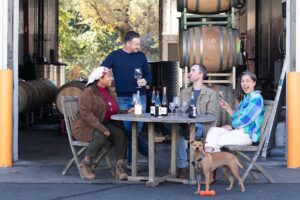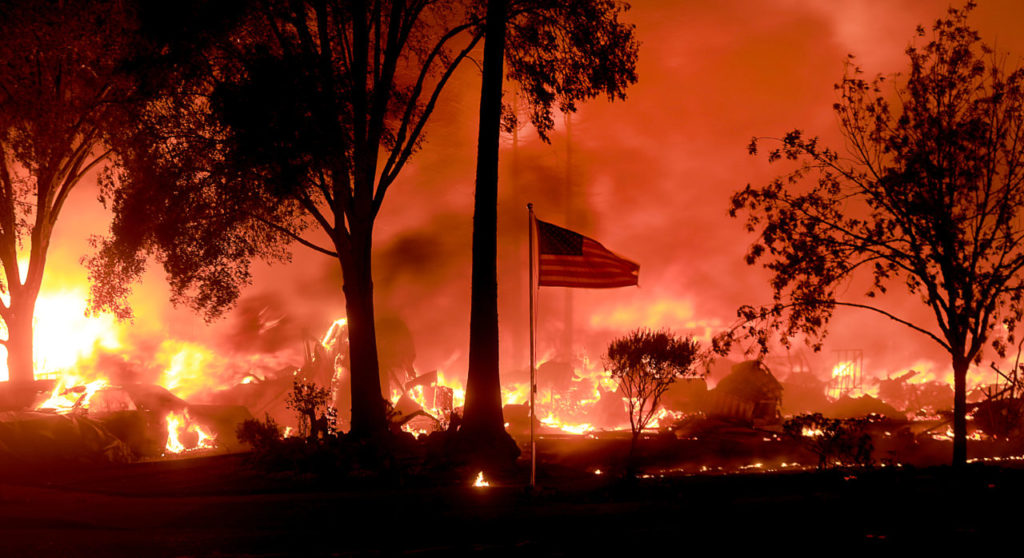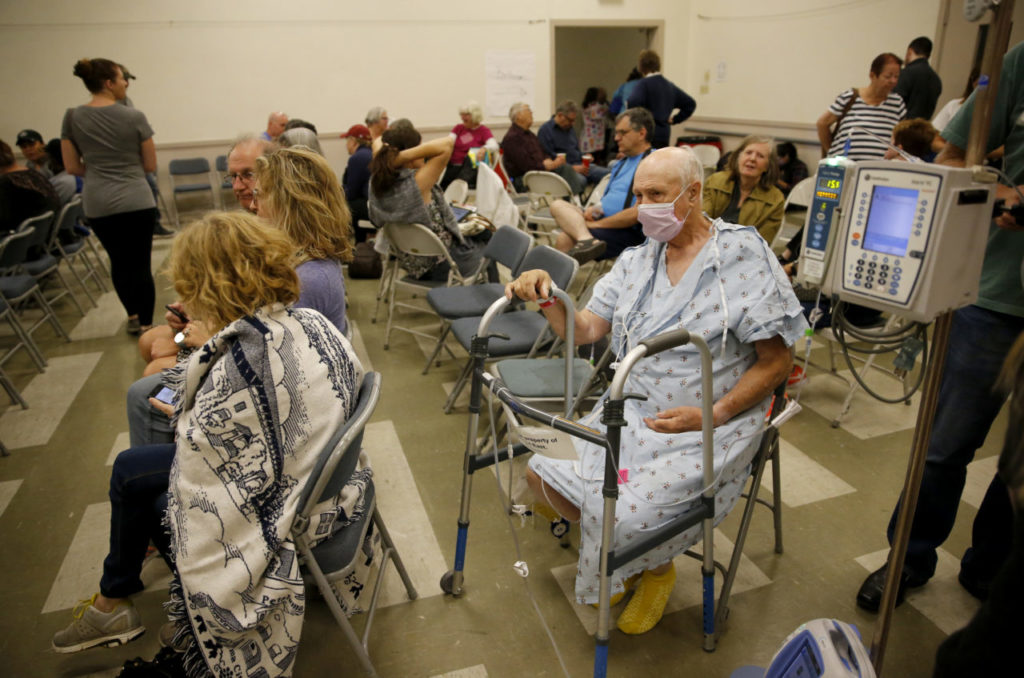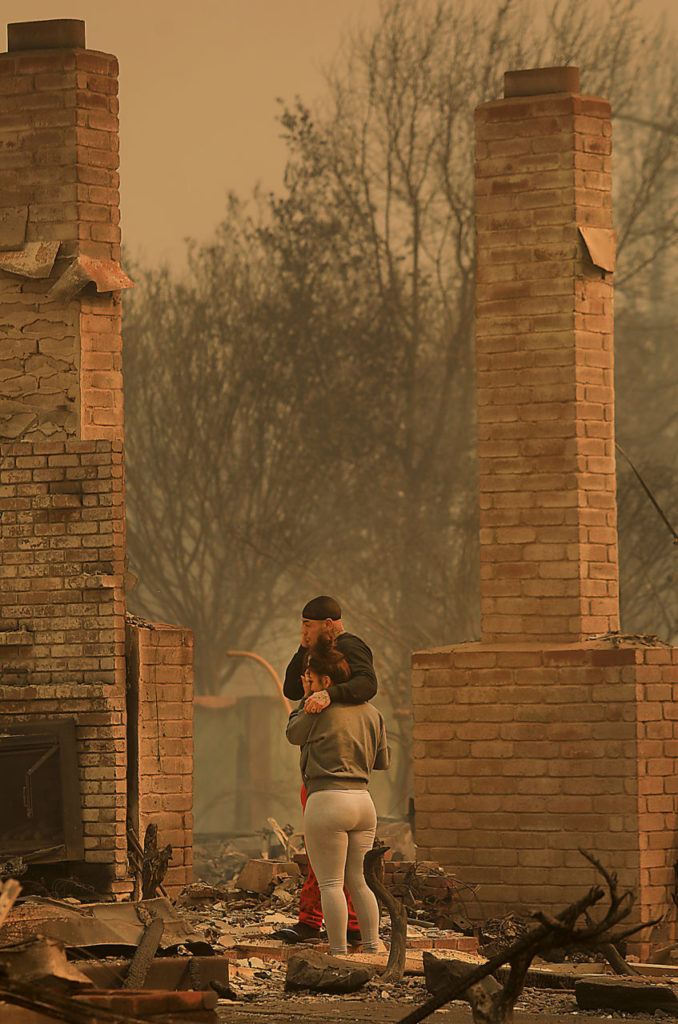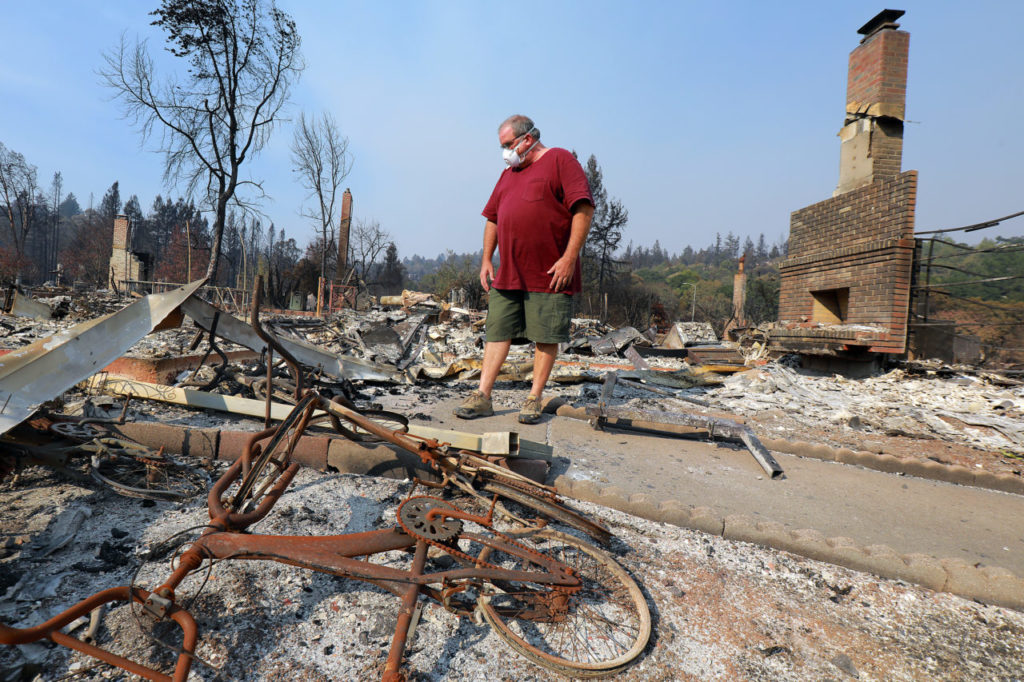The wind picked up a patio umbrella and flung it against the house, startling Martha Menth awake just before midnight.
She opened the door of her home along a wooded lane off Riebli Road in the foothills of the Mayacamas Mountains north of Santa Rosa and was hit by a huge blast of smoke. Dirt flew into her eyes. She slammed the front door shut and turned to her husband, who lay in a hospital bed in the living room, unable to walk after a stroke. “Don, wake up. There’s a fire,” Menth said.
She called her sister who lived up the hill. They were leaving. As the power went out and came on again, she got the garage door open, dressed her husband and heaved him into a wheelchair. She pushed him out onto the front deck to the electric wheelchair lift. Then, the power went out for good.
Night wasn’t dark anymore. The sky glowed red. Explosions — bursting propane tanks — punctuated the seconds. She fumbled with trembling hands to lower the chair with a manual crank, bombarded by smoke and flying embers.
“Every 10 rotations the chair only went down a fraction of an inch. I was watching the big red glow on the horizon,” Menth said. “The fire was loud, so loud, a guttural roar.”
They would join bumper-to-bumper traffic, people fleeing their homes in the woodlands between Calistoga and Santa Rosa, driving through flames, dodging downed power lines.
Eleven miles to the southeast in the Sonoma Valley, another fire was spreading fast, forcing people out of homes in Kenwood and Glen Ellen, and sending a front of flames westward up a hill toward ranches and forested enclaves of Bennett Valley.
Chris Bradshaw, his wife and son were tossing bags into cars on Sundown Lane and getting five horses out of the barn and to the pasture where they would survive by instinct and luck.
Bradshaw could see the flames coming as neighbors fled in pickups from Lawndale Road, driving off-road and onto his property and crashing through a fence to escape.
“Oh my god. We need to get out of here,’” Bradshaw thought.
By 12 a.m. October 9, six massive fires, and about a half-dozen smaller ones, were burning out-of-control simultaneously in four counties. Winds gusting up to 68 mph were unrelenting. Emergency dispatchers were taking more than 300 frantic 911 calls per hour, the amount they typically receive in a day. Dispatchers scrutinized maps of fire trails and helped people hike to safety when massive trees fell across the road, blocking the way out. They stayed on the line during harrowing ordeals with people trapped in pools or houses. They sent emergency personnel to homes when it was already too late.
“It went from one spot fire to hundreds and hundreds of spot fires, from one house on fire to hundreds and hundreds of houses on fire,” said KT McNulty, who was supervising Sonoma County’s 911 dispatch center that night.
Embers flew a half-mile ahead of fire fronts. Flames sheeted across roads that would normally hold fire at bay, at least long enough for crews to beat it back. But there was no firefight this night.
For the firefighters, deputies, police and ambulance crews heading into those burning hills, it was like racing a freight train. Run alongside the flames, get out front, get people out of harm’s way. Any misstep could send you into a wall of fire.
Off Mark West Springs Road in the hills between Calistoga and Santa Rosa, Cal Fire Battalion Chief Gino DeGraffenreid was about to jump back into his truck after loading a fleeing family into a police car when he thought he heard someone yelling amid the roaring wind and fire.
He ran toward the voice and saw them: a couple wearing next to nothing, freezing amid the raining firebrands.
“They were soaking wet,” DeGraffenreid said. “They had awoken to a smoke detector, jumped in the pool and for about an hour had been in the pool trying to stay away from heat.”
He wrapped them in T-shirts, put them into his truck and caravanned with police down Michele Way to Mark West Springs Road, a white-knuckle trip through a burning neighborhood already wiped clean of all that had once been so familiar. The auto shop. The white pasture fences. The goofy Volkswagen bug. Gone.
“This fire was going to kill people,” DeGraffenreid said. “We knew it that night.”
Diablo winds come from the northeast, bringing dry inland air over a North Coast normally hugged by the moist marine layer coming off the Pacific Ocean. They’re Northern California’s version of Santa Ana winds, famous for stoking Southern California wildfires like those that erupted in December.
If the Oct. 8 winds had arrived one month later, after steady rains began taking the edge off months of dry weather, they still would have ripped the limbs from trees and toppled towering oaks and pine. They would have knocked power lines down onto the ground. Fires would have started, but they might not have taken flight as they did in the parched woodlands.
The winds began buffeting the region like a switch was flipped about an hour after nightfall.
Firefighters were outgunned, at first by the sheer number of fires, fallen trees and downed power lines sending engines every which way — to a small grass fire off Todd Road southwest of Santa Rosa or a tree across Highway 128 in Knights Valley.
The bigger fight was to come.
Flames took hold on a hill north of Calistoga city limits about 9:45 p.m. near Highway 128. Around the same time, a fire ignited about 25 miles to the southeast off Atlas Peak Road near Lake Berryessa in Napa County. By 10 p.m., flames lit up a gulch along sparsely traveled Nuns Canyon Road near Glen Ellen in Sonoma Valley.
Fires set into the tinder-dry trees and underbrush, surging into infernos, rousting tens of thousands of people out of their beds and pushing them onto the roads, surrounded by horrific flames, unrelenting smoke, enduring a terror-filled night.
People pounded on doors to make sure their neighbors were awake and evacuating. Homeowners turned on every garden hose they could find on their block. Cellphones lit up across the county, calls from people making sure loved ones were out of bed. People abandoned cars along the roadways to get into strangers’ vehicles, afraid to get stuck in traffic surrounded by flames.
A Harley-Davidson parked on its kickstand partially blocked Santa Rosa Fire Battalion Chief Mark Basque’s way on Mark West Springs Road. Nearby, a sedan had crashed into an SUV, and wedged underneath the now burning vehicle. Basque peered into the windows with a flashlight. Air bags were deployed. No one was inside. Over and over, he and others would stop to check abandoned cars strewn along the roads shrouded by smoke and flames.
“Where are the people? This is not survivable,” Basque said.
The Sonoma County fires would continue burning for more than three weeks, scorching 137 square miles, destroying 5,130 homes and killing 24 people. The deadliest blaze, the Tubbs fire that ravaged Santa Rosa, became California’s most destructive wildfire. Two other fires, in Napa and Mendocino counties, would kill an additional 16 people.
The simultaneous nature of these fires tested the state’s firefighting force, a system built on shifting resources from place to place to answer the current need. But the first night, and for the next several days, there were too many places in need — from hillside communities in Napa County to subdivisions in Lake County’s Clearlake to the Potter and Redwood valleys in Mendocino County.
“The system is built for the large-scale emergency,” Basque said. “But it’s not built for a half dozen large-scale emergencies at the same time in the same area.”
No one knows yet what ignited the fire that lit in dry vegetation north of Calistoga. Cal Fire investigators took as evidence fallen power lines that had detached from a home on Bennett Lane, although utility officials for PG&E said not all of the equipment was theirs.
About three miles southwest of the fire’s origin, Anne Pentland stepped outside her home on Mountain Home Ranch Road that night. The wind and smoke hit like a wall. She went back inside and called 911. A dispatcher told her fire was just north of the Calistoga city limits. About 15 minutes later she received an urgent text message from a neighbor: The whole hillside was ablaze.
The Tubbs fire would make a horrific 12-mile run in just over four hours — burning the breadth of a football field each minute — from the northern edge of the Napa Valley through the foothills of the Mayacamas Mountains into a dense city neighborhood in west Santa Rosa. It raced through ranches and rural communities, sweeping through million-dollar homes in Santa Rosa’s hillside Fountaingrove development and tract neighborhoods in Larkfield-Wikiup.
Just before 2 a.m., the ferocity of the firestorm propelled it across Highway 101, flinging garage doors and all manner of debris across six lanes, a treacherous storm for motorists compelled to flee yet unable to see.
“You’re praying there’s not stopped traffic in front of you because you’re not going to see them,” said Sonoma County Sheriff’s Sgt. Spencer Crum, who had just been at an apartment complex loading people into cars and ambulances and left with a knot in his chest, dreading that not everyone got out. “It was the heaviest fog you can imagine, it was like driving blind.”
Then the fire did the unimaginable: On the west side of the highway, it burned more than 1,300 tightly packed homes in Coffey Park. The rainfall of embers and flames would level the neighborhood, leaving only charred chimneys and melted vehicles to mark where homes once stood.
The wind at 2 a.m. lifted 30-year-old Cecilia Rosas off the ground outside her home near Guerneville and Fulton roads — about a mile west of her parents’ house on Santiago Drive in Coffey Park. She was watching the orange glow to the east, calling her mom and urging them to get into their car and leave. Her mother stepped into shoes, grabbed keys and ran outside with embers falling all around.
About that time, the cellphone of State Sen. Mike McGuire began lighting up, jolting the light sleeper out of his hotel bed in Washington, D.C., with calls, texts and startling photographs from staff and firefighter friends back home. The reports kept piling up: massive winds, fires overrunning entire neighborhoods, flames crossing Highway 101. One image translated the enormity of what was taking place: Kmart in flames. The big store with its iconic red letter on the highway for decades, where McGuire’s mother took him to shop for Bluelight specials.
“I just couldn’t believe what I was hearing and seeing, that fire had jumped the highway,” McGuire said. “Then I was told there were thousands of evacuated people at Finely Center in Santa Rosa, but there was no food.”
He cut his trip short, got onto an early morning flight back, and by nightfall he would be standing on the bridge over the highway near the destroyed Kmart, watching unrelenting flames still devouring a Hilton hotel on the hill. “I never, never would have thought in all my years that we’d be standing on an overpass, with Highway 101 closed, watching Fountaingrove on fire,” McGuire said.
All told, 44 people died across Northern California. Some died while asleep in their beds. Some got as far as cars in garages. A woman succumbed to heat and smoke in her husband’s arms. A 14-year-old boy was overrun by flames, separated from his family fleeing on foot from fire blitzing Redwood Valley. A 44-year-old Santa Rosa engineer died six weeks later in a burn unit at UC Davis Medical Center.
Cal Fire’s DeGraffenreid had hours earlier asked every station in six counties to be on alert and fully staffed because of the winds predicted that night. And within about 10 minutes of the Tubbs fire’s start, DeGraffenreid could tell from the radio reports he received driving from west Santa Rosa that the fire was spreading fast. He called for two chief officers and 10 engines, ordering Cal Fire crews keeping a fence fire from spreading to a house south of Windsor to leave immediately and head east.
Erratic, gusty winds had on- and off-duty firefighters throughout the region listening to their emergency radios, and DeGraffenreid’s call had many jumping into their trucks and engines to head to the fire.
At his home near Healdsburg, Chief Basque told his wife he had to go. He helped put out two grass fires on either side of Highway 101 in Windsor, then headed toward Calistoga.
A wall of fire cut him off at Franz Valley School Road, so he went around another rural road. He and other firefighters found the mountainous community already aflame. At one point, a car raced up out of the smoke, its panicked driver carrying passengers with burns. They begged him to go back into the fray for a man who had fallen behind after hurting an ankle.
Using his PA system, Basque called out and “by some small miracle” the man responded. Basque got him out, as well as a group of neighbors who had huddled in a pool.
Basque headed back toward Santa Rosa, unable to see through thick smoke and fires, making his way by keeping the wheels on the raised dots in the middle of the road, shocked to see Pacific Heights and Ursuline neighborhoods totally aflame.
Sonoma County sheriff sergeants Brandon Cutting and Spencer Crum smelled smoke about midnight at the department’s headquarters in Santa Rosa, and radioed dispatch. Three to four fires were burning around the county.
Crum stayed behind as Cutting headed west, and as soon as he reached Porter Creek and Petrified Forest roads he radioed back to Crum reporting “a lot of flames.” About that time, 911 calls were flooding into dispatchers, people needed help on Franz Valley Road, Mountain Home Ranch Road. “There was no area that wasn’t catching fire,” Cutting said.
He pulled up next to a fire investigator idling in a Crown Vic, and asked “What are you doing?”
“He said, ‘At this point it’s a rescue, there’s no firefight in this. This fire is moving fast. When you think you’ve gone far enough, go further,’” Cutting said.
Now a grandmother, Martha Messana remembers being 12 years old when her mother loaded her and bags of belongings into the back of a pickup parked in a barn at the family ranch settled by her Italian grandparents and told her to stay put. Messana cowered in the back, listening to the wind howl and the fire crackle for hours as her parents battled flames from the 1964 Hanly fire, keeping the fire from reaching their Riebli Road ranch.
This time, 53 years later, the Tubbs fire traced the same path but much faster — burning from Calistoga to Santa Rosa in just over four hours versus the three days it took flames to reach Chanate Road in 1964. It devoured the ranch’s iconic white barns.
And this time, there were thousands more people living in the wooded hillsides. Sprawling ranches were divided into modern estates. Wooded acres became subdivisions, golf courses, elder care facilities and home to Keysight Technologies’ 200-acre Santa Rosa campus.
The local firefighting force was utterly outmatched. Urgent calls for more engines, hand crews, dozers and air support would go largely unanswered during those first critical hours. The help that finally arrived wasn’t enough.
By 3 a.m., firefighters were abandoning a meeting point at the Kmart parking lot at Cleveland Avenue and Industrial Drive as flames devoured the big box store. They’d called for more resources, requesting a massive influx of 25 strike teams — about 125 fire engines and hundreds of personnel. Windsor Fire Chief Jack Piccinini was directing crews battling fires burning across the Coffey Park neighborhood, waiting with a sinking heart as the requests for assistance went unanswered.
“I’ve asked, ‘Are units coming?’ and was told no, they’re going to the Atlas fire (in Napa County). That’s painful news to us. We’re still spread so thin,” he said.
Piccinini’s 94-square-mile fire district, covering most of Santa Rosa’s outskirts, would lose nearly 1,500 homes. Twelve of the 22 people killed in the Tubbs fire lived there.
In Fountaingrove, Gold Ridge fire engineer Vail Bello, his wife and teenaged son battled on a fire crew, and like so many out there that night they were a skeleton team against Goliath fires. “Our orders were tactical firefighting, find fire and save what you can,” said Bello. “It was like Armageddon, something I’ve never seen before and hope to never see again.”
Then, the hydrants began to fail. They lost pressure or ran dry, sending firefighters in Larkfield to nearby Sutter hospital to tap into its emergency tank, while those in Coffey Park headed to other neighborhood to refill, losing precious time. Monday night, hydrants high up on Fountaingrove failed, forcing Bello and other firefighters there to drive down the hill to Mendocino Avenue for water.
At that point, the main hope was for the winds to die down.
Later, over the course of weeks, crews from 382 fire agencies, 14 states and a team from Australia responded to help. Reinforcements from 82 law enforcement agencies came, putting men and women in uniforms of all colors in destroyed neighborhoods. A pair of cops from San Jose finished a graveyard shift in their city, then headed north to help guard the entrance to Parker Hill Road.
The National Guard arrived, fresh-faced young men and women in fatigues, stationed at roadblocks across the county, turning mundane sights into surreal occupation zones: near the Home Depot at Bicentennial Way in north Santa Rosa, the Redwood Adventist Academy on Mark West Springs Road, past the Pool Mart store just outside Boyes Hot Springs in the Sonoma Valley.
The smoke belching from the fires shrouded the region in an ochre pall. For days, ash rained from the sky.
It would be one week before Santa Rosa Mayor Chris Coursey, Sonoma County Board of Supervisors Chairwoman Shirlee Zane and other elected officials would survey the damage from above in a helicopter, a flight that captured the enormity of what took place and what was ahead. Coursey said he felt as if he were peering into the private grief of thousands.
We’re all going to really need each other,” he would later say on a cloudless day, standing at the podium for a remembrance ceremony held outdoors at Santa Rosa Junior College recognizing what was lost and the long recovery ahead.
The death toll increased each day, as fires were put out and charred rubble cooled enough for volunteers with trained dogs to begin a solemn parcel-by-parcel search.
They were doctors, a football coach, a conservationist, military veterans, Red Cross volunteers, parents and grandparents. Most were retirement age. Many were trapped by the fire in the homes where they’d lived for decades. A Santa Rosa woman died while trying to save her dogs. Flames trapped and overpowered a man, in the area visiting family, as he scrambled to find the keys to his truck. Neighbors pounded on the door of a retired teacher, a Coffey Park resident with hearing loss, and she never responded.
In Sonoma County, the youngest to die was 27, the oldest 101.
Thousands more endured near-death escapes, left with their lives but also painful burns and haunting memories.
On Hanover Place in Fountaingrove, Patrick McCallum and his wife, Judy Sakaki, were sleeping after a night celebrating their first wedding anniversary with dinner at Bird & the Bottle restaurant near downtown Santa Rosa.
They were not aware of the firestorm brewing outside until about 4 a.m. when a smoke alarm sounded in their home. The house was on fire. They ran for their lives, hot pavement burning their feet, her hair singed by flying embers.
Sakaki told the firefighter who picked them up that she was president of Sonoma State University. At once panicked and clear headed, McCallum saw each house they passed, fearing for his neighbors, fixating on the house where he’d see three children playing outside.
“As we’re running up the hill, we’re in horror thinking everyone had died in their houses,” McCallum said.
They would run past a home where Tak-Fu Hung died in his doorway. The 101-year-old retired civil engineer had battled as a general with the Kuomintang against Mao Zedong’s revolutionary army, fled to Taiwan, raised six sons and a daughter. As fires burned all around, Hung knew he wouldn’t make it. He told his wife to leave him behind. Helen Hung, 76, ran, getting only as far as a low driveway wall, where she lay on the hot pavement, cowering for five hours as flames raged all around, until help arrived.
Near Brush Creek Road north of Highway 12 in Santa Rosa, Beverly Gooch, 74, had taken a sleeping pill. About 2 a.m. she was jolted out of a medicated sleep by a neighbor’s insistent pounding on her door, the man yelling about a fire. She threw on a pair of shoes and ran outside. She jumped into her car, leaving the front door unlocked, garage door agape. She left behind her phone, purse and driving glasses.
Fire was burning in every direction, the hillsides to the north and east aglow.
As she drove away, two coyotes appeared on her suburban street, trotting on the pavement. In her groggy state she believed they were wolves coming for her.
She headed south, joining carloads of fleeing people, ended up at a gas station on Santa Rosa Avenue, where the attendant told her to head to the Sonoma County Fairgrounds. She showed up and ran into a woman she knew, Lorena Anaya, whose family runs a favorite taqueria where she and her late husband often ate. Anaya recognized her, threw a coat around her shoulders. They would spend the next two days together.
“She said to me, ‘Wherever we go, you go. You’re our family now,’” Gooch said.
Awakened by the wind, the smell of smoke, the sound of propane tanks exploding, a phone call from a worried friend, people across Sonoma County opened the doors of their homes into a world of hell. Fire in the hills to the east. Fire in the streets to the west.
Few received official warning before fire lit into the neighborhoods.
Crum, a sheriff’s spokesman, fired off a succession of increasingly urgent public warnings about the fires, starting just before 11 p.m., sending eight messages in seven hours: Fires advancing down Mark West Springs Road toward Santa Rosa, into Kenwood and Glen Ellen.
At 11:37 Sheriff Rob Giordano ordered an automated phone call go out issuing evacuations from the Larkfield area to the Napa County border. The calls went to landlines in that area, and also cellphones and emails for those who had previously signed up. Few had.
County emergency staff chose not to use an official government messaging system that pushes warnings to cell phones – most commonly used for Amber Alerts child abduction messages — a controversial move lambasted by residents who said the warning could have saved lives.
As residents clogged the roads heading out, firefighters and law enforcement officers streamed into the mountainous region between Santa Rosa and Calistoga, praying trees wouldn’t block their escape as they drove up narrow driveways and pounded on doors to get people out.
The terrain — a rolling mountainous region cut by creeks and canyons — meant residents couldn’t see how close the fire was. Some pockets had no cell or emergency radio reception.
Crum left the office and headed west into the hills, joining deputies and police pounding on doors, directing traffic, getting fleeing people into patrol cars, firetrucks and ambulances. People were panicking and some refused to go, forcing deputies to argue or leave them behind.
Monte Rio Fire Chief Steve Baxman’s truck caught fire somewhere near Riebli Road and a tree came crashing down, smashing a window. When he stopped to remove the tree, a burned woman ran up calling for help.
“If we didn’t hit that tree, she would have died,” Baxman said.
Baxman continued down the hill, and when he got to Cardinal Newman High School — where he graduated in 1970 — the gym was burning.
Dispatchers sent him toward nearby Angela Drive where someone was in immediate peril, but Baxman was stopped by powerful flames. Authorities would later find human remains.
Dawn didn’t come with the sunrise. The wind tore through Coffey Park. Firewhirls — small fire tornadoes — ripped garage doors away and threw them into the street, flipped cars onto their roofs.
But by about 6 a.m., as if another switch was flipped, the winds let up, giving firefighters a chance to make a stand. The mission: Pick a spot, reach a hydrant and save a home. Dennis Lane, Vermillion Street, Crimson Lane, Barnes Road, all streets where they made a stand. They saved some houses but lost many others.
“There were blocks where there was nothing we could do,” Baxman said. “It was personal, it’s our hometown.”
Residents waited for the rumbling sound of the air tankers overhead, wishing for clouds of neon-pink fire retardant to rain down on the unrelenting fires. “Where are the tankers?” they asked. But air operations didn’t begin in earnest until Wednesday with the clearing of a low ceiling built from the billowing smoke and ash that created the worst air quality on record across the Bay Area.
Fire moves in various ways, running up slopes, backing down hills. Depending on the terrain, weather and fuel, it creeps in some places but torches in others.
It headed south from Fountaingrove into the neighborhood north of Hidden Valley Elementary School, where its spread was at times a slow methodical burn, going house to house.
Off Parker Hill Road, Larry Broderick packed his wife and their three boys into the car shortly after a neighbor pounded on their door at 1:30 a.m. Broderick, 51, stayed behind to try to save their Flintwood Drive home in the neighborhood where he has lived since he was 5 years old.
Pulling every garden hose he could find, Broderick wet down roofs, fences and bushes on his block, calling upon the tactics he’d learned during a yearlong stint in the state fire service several decades ago. He tried to avoid being spotted by emergency responders so he wouldn’t distract them.
Broderick managed to extinguish fires on several neighbors’ homes and fences with the goal “to hold it at bay on my block until the sun came up and winds died, or a strike team came in.”
But the winds persisted. The fire engines with rescuers didn’t arrive. And the flames came roaring from three directions, converging down into his neighborhood.
Fire lit up a stand of tall pines across the street. Broderick took a hard fall when a hose got caught on one of his son’s bikes, and his glasses flew off his face. He looked up and the fire had “quadrupled” in size.
By 7:15 a.m., his fight was over. Broderick got in his SUV and drove out. He was out of breath. The sky was still dark as he drove through fire burning the homes of his neighbors, his friends.
At least five families in his son’s Cub Scout’s troop would lose their homes. His children’s neighborhood school, Hidden Valley Satellite, burned to the ground.
Across Sonoma County, nearly 1,500 grade school children and 900 Santa Rosa Junior College students were left without homes, and nearly 150 teachers, kindergarten through 12th grade. The homes belonging to more than 200 physicians, most with ties to Santa Rosa’s three major hospitals, are gone.
Broderick would go back before nightfall, slipping past roadblocks thrown up to keep people out of areas still burning, and saw the rubble that was once his home. The twisted mattress wires marked the beds where he, his wife and their three boys — ages 5, 8 and 9 — had slept the previous night. There was almost nothing left intact, but as he kicked around the charred remains he found a small ceramic vase, a simple thing with pink flowers that he brought back from a trip to Ireland to give the woman who would eventually become his wife.
But it was too hot to touch. He left it behind.
WHERE SONOMA COUNTY BURNED
POCKET FIRE: The 17,357-acre Pocket fire burned in remote, hilly terrain east of Geyserville and destroyed a handful of structures. The fire ignited about 3:30 a.m. Oct. 9 off Pocket Ranch and Ridge Ranch roads in Geyserville, and was declared contained Oct. 31.
TUBBS FIRE: In just over four hours, the Tubbs fire spread 12 miles from its origins north of Calistoga along Bennett Lane and Highway 128 through the Petrified Forest and Mark West Creek corridor and into neighborhoods of north Santa Rosa. The fire ignited about 9:45 p.m. Oct. 8 and continued burning for 23 days, finally contained on Oct. 31 with 36,807 total acres burned, the vast majority in Sonoma County.
NUNS FIRE: Five fires converged to burn 56,556 acres in Sonoma and Napa counties, centered in the Mayacamas hills and the Sonoma Valley. The Nuns fire ignited about 10 p.m. Oct. 8 off Nuns Canyon Road less than a half-mile northeast of Highway 12 in Glen Ellen.
Over several days, the fire joined with smaller fires – the Adobe, Norrbom, Partrick and Oakmont fires – that burned areas of Kenwood, Trione-Annadel State Park, Bennett Valley and Napa County. Nearby, the Pressley fire burned about 791 acres along Crane Ranch Road east of Rohnert Park.









